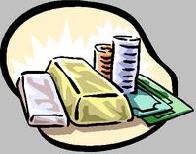
 |
|
| Financial Terms | |
| Accrued expenses payable |
|
Information about financial, finance, business, accounting, payroll, inventory, investment, money, inventory control, stock trading, financial advisor, tax advisor, credit.
Main Page: investment, inventory control, money, inventory, financial, business, accounting, tax advisor, |
Definition of Accrued expenses payable
Accrued expenses payableexpenses that have to be recorded in order for the financial statements to be accurate. accrued expenses usually do not involve the receipt of an invoice from the company providing the goods or services. accrued expenses payableThe account that records the short-term, noninterest-
Related Terms:operating leverageA relatively small percent increase or decrease in Accounts payableMoney owed to suppliers. Accrued interestThe accumulated coupon interest earned but not yet paid to the seller of a bond by the Annual fund operating expensesFor investment companies, the management fee and "other expenses," Payable through draftsA method of making payment that is used to maintain control over payments made PayablesRelated: Accounts payable.  ACCOUNTS PAYABLEAmounts a company owes to creditors. GENERAL-AND-ADMINISTRATIVE EXPENSESWhat was spent to run the non-sales and non-manufacturing part of a company, such as office salaries and interest paid on loans. OPERATING EXPENSESThe total amount that was spent to run a company this year. SELLING EXPENSESWhat was spent to run the sales part of a company, such as sales salaries, travel, meals, and lodging for salespeople, and advertising. VARIABLE EXPENSESThose that vary with the amount of goods you produce or sell. These may include utility bills, labor, etc. ExpensesThe costs incurred in buying, making or producing goods and services. Accounts payableAmounts owed by the company for goods and services that have been received, but have not yet been paid for. Usually Accounts payable involves the receipt of an invoice from the company providing the services or goods. Bonds payableAmounts owed by the company that have been formalized by a legal document called a bond. ExpensesCosts involved in running the company.  Interest payableThe amount of interest that is owed but has not been paid at the end of a period. Loans payableAmounts that have been loaned to the company and that it still owes. Notes payableAmounts owed by the company that have been formalized by a legal document called a note. Payroll taxes payableThe amount of payroll taxes owed to the various governments at the end of a period. Prepaid expensesexpenses that have been paid for but have not yet been used up; examples are prepaid insurance and prepaid rent. Salaries payableSalaries that are owed but have not been paid at the end of a period. accounts payableShort-term, non-interest-bearing liabilities of a business fixed expenses (costs)expenses or costs that remain the same in amount, revenue-driven expensesOperating expenses that vary in proportion to unit-driven expensesexpenses that vary in close proportion to changes variable expensesexpenses that change with changes in either sales volume Accrued InterestThe amount of interest accumulated on a debt security between Accounts payableAcurrent liability on the balance sheet, representing short-term obligations Accounts PayableAmounts due to vendors for purchases on open account, that is, not evidenced Accounts Payable Days (A/P Days)The number of days it would take to pay the ending balance Accrued IncomeIncome that has been earned but not yet received. For instance, if you have a non-registered Guaranteed Investment Certificate (GIC), Mutual Fund or Segregated Equity Fund, growth accrues annually or semi-annually and is taxable annually even though the gain is only paid at maturity of your investment. Accrued InterestThe amount of interest owing but not paid. Fixed ExpensesCost of doing business which does not change with the volume of business. Examples might be rent for business premises, insurance payments, heat and light. Operating ExpensesThe amount of money the company must spend on overhead, distribution, taxes, underwriting the risk and servicing the policy. It is a factor in calculating premium rates. current liabilitiesCurrent means that these liabilities require payment in Related to : financial, finance, business, accounting, payroll, inventory, investment, money, inventory control, stock trading, financial advisor, tax advisor, credit. |